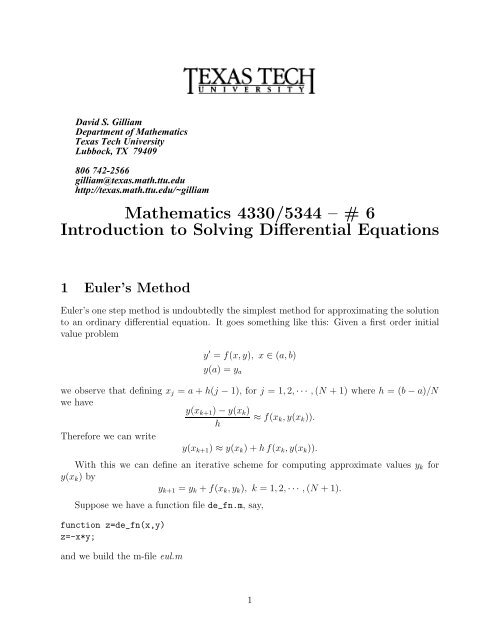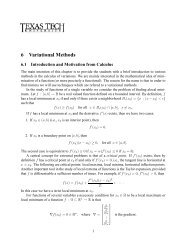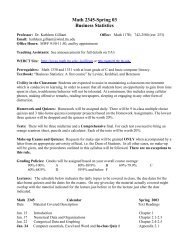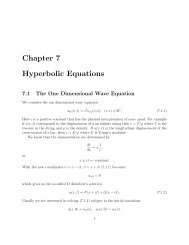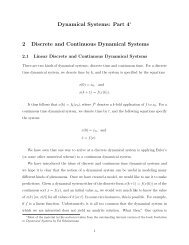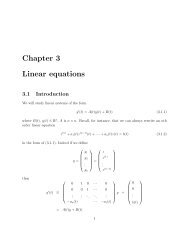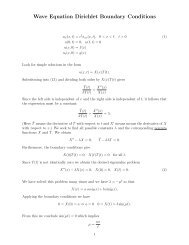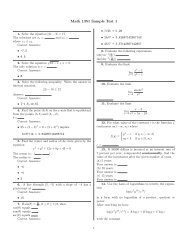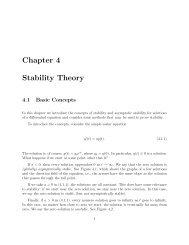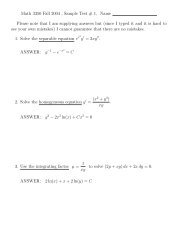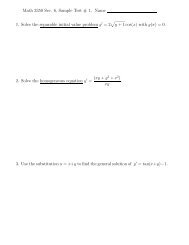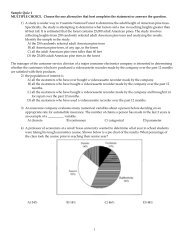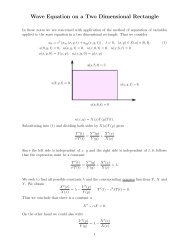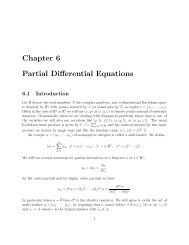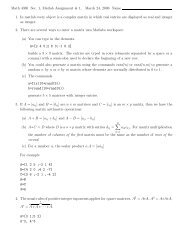Matlab Lesson 6 for Math 4330 and 5344 - Texas Tech University
Matlab Lesson 6 for Math 4330 and 5344 - Texas Tech University
Matlab Lesson 6 for Math 4330 and 5344 - Texas Tech University
Create successful ePaper yourself
Turn your PDF publications into a flip-book with our unique Google optimized e-Paper software.
David S. Gilliam<br />
Department of <strong>Math</strong>ematics<br />
<strong>Texas</strong> <strong>Tech</strong> <strong>University</strong><br />
Lubbock, TX 79409<br />
806 742-2566<br />
gilliam@texas.math.ttu.edu<br />
http://texas.math.ttu.edu/~gilliam<br />
<strong>Math</strong>ematics <strong>4330</strong>/<strong>5344</strong> –#6<br />
Introduction to Solving Differential Equations<br />
1 Euler’s Method<br />
Euler’s one step method is undoubtedly the simplest method <strong>for</strong> approximating the solution<br />
to an ordinary differential equation. It goes something like this: Given a first order initial<br />
value problem<br />
y ′ = f(x, y), x∈ (a, b)<br />
y(a) =y a<br />
we observe that defining x j = a + h(j − 1), <strong>for</strong> j =1, 2, ··· , (N + 1) where h =(b − a)/N<br />
we have<br />
y(x k+1 ) − y(x k )<br />
≈ f(x k ,y(x k )).<br />
h<br />
There<strong>for</strong>e we can write<br />
y(x k+1 ) ≈ y(x k )+hf(x k ,y(x k )).<br />
With this we can define an iterative scheme <strong>for</strong> computing approximate values y k <strong>for</strong><br />
y(x k )by<br />
y k+1 = y k + f(x k ,y k ),k=1, 2, ··· , (N +1).<br />
Suppose we have a function file de_fn.m, say,<br />
function z=de_fn(x,y)<br />
z=-x*y;<br />
<strong>and</strong> we build the m-file eul.m<br />
1
clear<br />
% this program calls the function file de_fn.m<br />
a=input(’left end point a = ’);<br />
b=input(’right end point b = ’);<br />
N=input(’ number of sub-intervals, N = ’);<br />
ya=input(’initial value at x=a, ya= ’);<br />
h=(b-a)/N;<br />
x=a+h*(1:(N+1));<br />
lx=length(x);<br />
y(1)=ya;<br />
<strong>for</strong> j=1:N<br />
y(j+1)=y(j)+h*f(x(j),y(j));<br />
end<br />
plot(x,y)<br />
This method can also be applied to higher dimensional problems as demonstrated in the<br />
following example. Consider the second order initial value problem<br />
y ′′ = f(x, y, y ′ ), x ∈ [a, b]<br />
y(a) =y a<br />
y ′ (a) =y pa<br />
If we set w = y <strong>and</strong> z = y ′ , then the system can be written as<br />
[ ] [ ]<br />
d w z<br />
=<br />
dx z f(x, w, z)<br />
w(a) =y a<br />
z(a) =y pa<br />
The numerical approximation can now be carrried out just as above. Suppose we have a<br />
function file de2_fn.m, say,<br />
function z=de2_fn(x,y,yp)<br />
z=-x*y/(yp^2+1);<br />
Now we build an m-file eul2.m to solve the problem.<br />
clear<br />
% this program calls the function file de2_fn.m<br />
a=input(’left end point a = ’);<br />
b=input(’right end point b = ’);<br />
N=input(’ number of sub-intervals, N = ’);<br />
ya=input(’initial value at x=a, y(a)= ’);<br />
yap=input(’initial value at x=a, y’’(a)= ’);<br />
h=(b-a)/N;<br />
2
x=a+h*(1:(N+1));<br />
lx=length(x);<br />
w(1)=ya;<br />
z(1)=ypa;<br />
<strong>for</strong> j=1:N<br />
w(j+1)=w(j)+h*z(j);<br />
z(j+1)=z(j)+h*de2_fn(x(j),w(j),z(j));<br />
end<br />
y=w;<br />
plot(x,y)<br />
There are many variations on the Euler method. Some of them are given in the first<br />
exercise in this lesson.<br />
2 <strong>Matlab</strong> Builtin ODE Solvers<br />
In addition there are many other methods <strong>for</strong> approximating solutions to ordinary differential<br />
equations, but due to a lack of time left in the semester I will just introduce you to <strong>Matlab</strong>s<br />
builtin Runge-Kutta solver ode45 <strong>and</strong> show you how it works. I will also give you a copy<br />
of a more recent version of the ode45 solver which comes from a collection of files in the<br />
ode suite which were written by researchers at SMU in Dallas. This new version is now the<br />
st<strong>and</strong>ard version in the newest <strong>Matlab</strong> version 5.<br />
Here is the help file <strong>for</strong> the solver in your current version of <strong>Matlab</strong>.<br />
ODE45 Solve differential equations, higher order method.<br />
ODE45 integrates a system of ordinary differential equations using<br />
4th <strong>and</strong> 5th order Runge-Kutta <strong>for</strong>mulas.<br />
[T,Y] = ODE45(’yprime’, T0, Tfinal, Y0) integrates the system of<br />
ordinary differential equations described by the M-file YPRIME.M,<br />
over the interval T0 to Tfinal, with initial conditions Y0.<br />
[T, Y] = ODE45(F, T0, Tfinal, Y0, TOL, 1) uses tolerance TOL<br />
<strong>and</strong> displays status while the integration proceeds.<br />
INPUT:<br />
F - String containing name of user-supplied problem description.<br />
Call: yprime = fun(t,y) where F = ’fun’.<br />
t - Time (scalar).<br />
y - Solution column-vector.<br />
yprime - Returned derivative column-vector; yprime(i) = dy(i)/dt.<br />
t0 - Initial value of t.<br />
tfinal- Final value of t.<br />
y0 - Initial value column-vector.<br />
tol - The desired accuracy. (Default: tol = 1.e-6).<br />
trace - If nonzero, each step is printed. (Default: trace = 0).<br />
3
OUTPUT:<br />
T - Returned integration time points (column-vector).<br />
Y - Returned solution, one solution column-vector per tout-value.<br />
The result can be displayed by: plot(tout, yout).<br />
You should compare this with the help file from the new ode45.m solver from the ode<br />
suite.<br />
ODE45 Solve non-stiff differential equations, medium order method.<br />
[T,Y] = ODE45(’ydot’,TSPAN,Y0) with TSPAN = [T0 TFINAL] integrates<br />
the system of first order differential equations y’ = ydot(t,y) from<br />
time T0 to TFINAL with initial conditions Y0. Function ydot(t,y)<br />
must return a column vector. Each row in solution matrix Y<br />
corresponds to a time returned in column vector T. To obtain<br />
solutions at the specific times T0, T1, ..., TFINAL (all increasing<br />
or all decreasing), use TSPAN = [T0 T1 ... TFINAL].<br />
[T,Y] = ODE45(’ydot’,TSPAN,Y0,OPTIONS) solves as above with default<br />
integration parameters replaced by values in OPTIONS, an argument<br />
created with the ODESET function. See ODESET <strong>for</strong> details. Commonly<br />
used options are scalar relative error tolerance ’rtol’ (1e-3 by<br />
default) <strong>and</strong> vector of absolute error tolerances ’atol’ (all<br />
components 1e-6 by default).<br />
It is possible to specify tspan, y0 <strong>and</strong> options in ydot. If TSPAN<br />
or Y0 is empty, or if ODE45 is invoked as ODE45(’ydot’), ODE45 calls<br />
[tspan,y0,options] = ydot([],[]) to obtain any values not supplied<br />
at the comm<strong>and</strong> line.<br />
As an example, the comm<strong>and</strong>s<br />
options = odeset(’rtol’,1e-4,’atol’,[1e-4 1e-4 1e-5]);<br />
ode45(’rigid’,[0 12],[0 1 1],options);<br />
solve the system y’ = rigid(t,y) with relative error tolerance 1e-4<br />
<strong>and</strong> absolute tolerances of 1e-4 <strong>for</strong> the first two components <strong>and</strong><br />
1e-5 <strong>for</strong> the third. When called with no output arguments, as in<br />
this example, ODE45 calls the default output function ODEPLOT to<br />
plot the solution as it is computed.<br />
Lets look at a couple of other examples. One version of the van der Pohl oscillator is<br />
given by the following second order initial value problem on an interval (0,T), <strong>for</strong> T>0.<br />
4
d 2 z<br />
dt + 2 µ(z2 − 1) dz<br />
dt + z =0<br />
dz<br />
z(0) = z 0 ,<br />
dt (0) = z 1<br />
We trans<strong>for</strong>m this problem to a first order system by introducing y 1 = z <strong>and</strong> y 2 = dz<br />
[ ]<br />
dt<br />
y1<br />
<strong>and</strong> defining y = . With this we can write<br />
y 2<br />
[ ]<br />
d y1<br />
dt y 2<br />
y(0) =<br />
[<br />
=<br />
]<br />
z 1<br />
[<br />
z0<br />
]<br />
y 2<br />
µ(1 − y1)y 2 2 − y 1<br />
To solve this problem numerically we build a function file named vdpde.m<br />
function yp = vdpde(t,y)<br />
global MU<br />
yp(1)=y(2);<br />
yp(2)=MU*y(2).*(1-y(1).^2)-y(1);<br />
Now we build an m-file run_vdp.m to setup <strong>and</strong> run the problem. In this case I am going<br />
to use the new ode45.m routine from the ode suite. When you run the program you can pick<br />
various values of MU. You might start with MU=1. As you change this value, you will notice<br />
that the “limit cycle” can change considerably. Run the problem <strong>for</strong> several different initial<br />
conditions <strong>for</strong> the same MU <strong>and</strong> you will see why we speak of a limit cycle.<br />
clear<br />
clear global<br />
global MU<br />
t0=input(’ initial time t0 = ’);<br />
T=input(’ final time T = ’);<br />
MU=input(’ parameter MU = ’);<br />
v=input(’ vector of initial conditions v = [v1,v2] ’);<br />
[n,m]=size(v);<br />
if m>1<br />
v=v’;<br />
end<br />
tvec=t0:.025:T;<br />
[t,y]=ode45(’vdpde’,tvec,v);<br />
plot(y(:,1),y(:,2))<br />
5
As another example consider the famous Lorenz equations whose solution exhibits the<br />
so-called lorenz attractor.<br />
dy 1<br />
dt = 10(y 2 − y 1 );<br />
dy 2<br />
dt = (28 − y 3)y 1 − y 2 ;<br />
dy 3<br />
dt = y 1y 2 − (8/3)y 3 ;<br />
Build a function file lorenzde.m<br />
function dy=lorenzde(t,y)<br />
dy=[10*(y(2)-y(1)); (28-y(3)).*y(1)-y(2); y(1).*y(2)-(8/3)*y(3)];<br />
clear<br />
Now build a file run_lorenz.m to run the problem<br />
t0=input(’ initial time t0 = ’);<br />
T=input(’ final time T = ’);<br />
% initial condition; e.g. [1 -1 2]’<br />
v=input(’ vector of initial conditions v = [v1,v2,v3] ’);<br />
[n,m]=size(v);<br />
if m>1<br />
v=v’;<br />
end<br />
tvec=t0:.025:T;<br />
[t,y]=ode45(’lorenzde’,tvec,v);<br />
h1=figure<br />
plot(y(:,1),y(:,2))<br />
h2=figure<br />
plot(y(:,1),y(:,3))<br />
h3=figure<br />
plot(y(:,2),y(:,3))<br />
ASSIGNMENT 6 – <strong>Math</strong> <strong>4330</strong> <strong>and</strong> <strong>5344</strong><br />
1. This problem is concerned with several variations on the Euler’s method. I want you<br />
to modify your Euler program by adding each of these methods <strong>and</strong> then compare<br />
the resulting accuracy by finding the maximum of the absolute value of the difference<br />
of the solution <strong>for</strong> each method <strong>and</strong> the exact solution on a vector of x values<br />
x=linspace(a,b). Make a table to print out the results.<br />
6
(a) Euler y 1 = ya, y j+1 = y j + hf(x j ,y j )<br />
(b) Midpoint y 1 = ya, y j+1 = y j + hf ( x j + h 2 ,y j + h 2 f(x j,y j ) )<br />
(c) Modified Euler y 1 = ya, y j+1 = y j + h [<br />
f(xj ,y j )+f(x j ,y j + hf(x j ,y j )) ]<br />
2<br />
(d) Huen y 1 = ya, y j+1 = y j + h [<br />
f(xj ,y j )+3f(x j + 2h 4<br />
3 ,y j + 2h 3 f(x j,y j )) ]<br />
For this comparison take N = 50 <strong>and</strong> 100 <strong>and</strong> apply to the follwing differential equations:<br />
(a) y ′ = −y + x +1, 0 ≤ x ≤ 1, y(0) = 1, exact: y = x + e −x<br />
(b) y ′ = y + x, 0 ≤ x ≤ 2, y(0) = −1, exact: y = −x − 1<br />
(c) y ′ = x −2 − x −1 y, 1 ≤ x ≤ 2, y(1) = −1, exact: y = log(x) − 1 x x<br />
(d) y ′ = y − xy 3 e −2x , 0 ≤ x ≤ 1, y(0) = 1, exact: y =(x 2 +1) −1/2 e x<br />
In the table, include a column giving the values of h =(b − a)/N .<br />
2. Use ode45.m to solve the harmonic oscillator problem<br />
d<br />
dt y 1 =2y 2<br />
d<br />
dt y 2 = −2y 1<br />
y 1 (0)=0,<br />
y 2 (0)=1<br />
Plot (y 1 ,y 2 ), (t, y 1 ) <strong>and</strong> (t, y 2 ).<br />
I would use t0 =0<strong>and</strong>T =4π with t = linspace(t0,T,300).<br />
7


